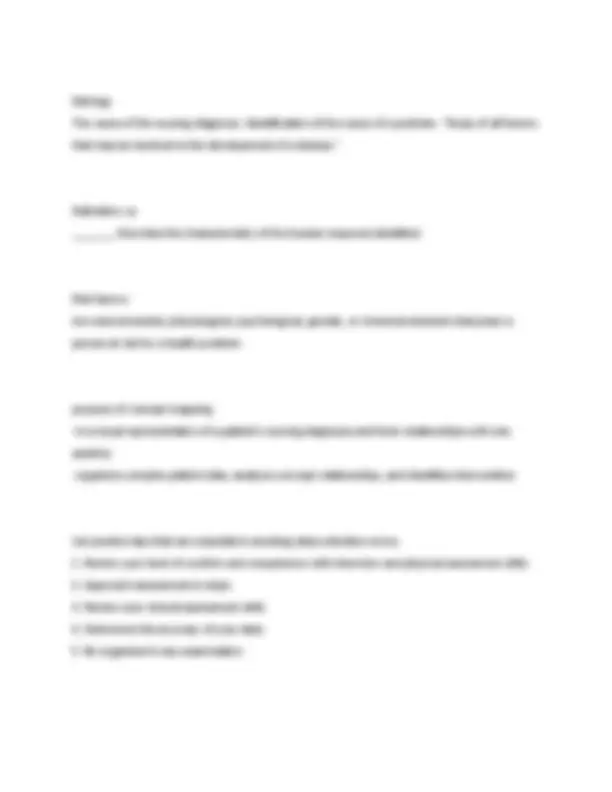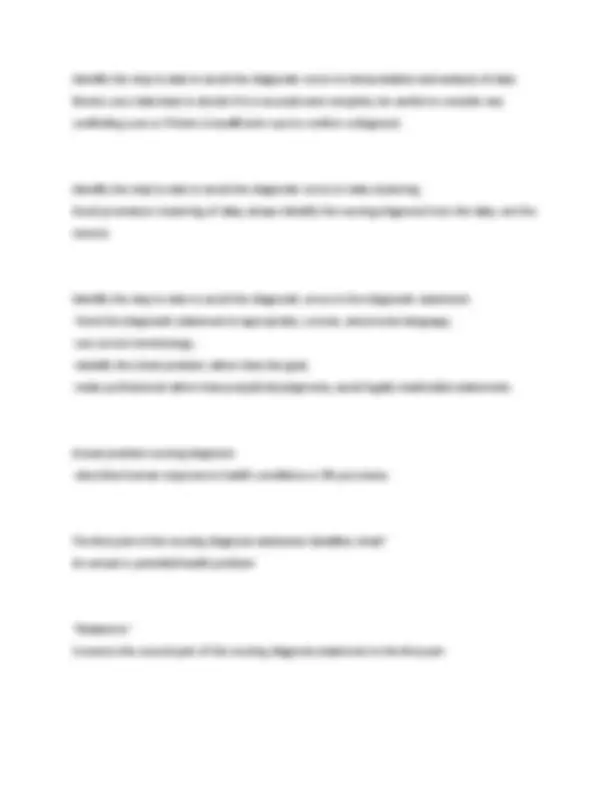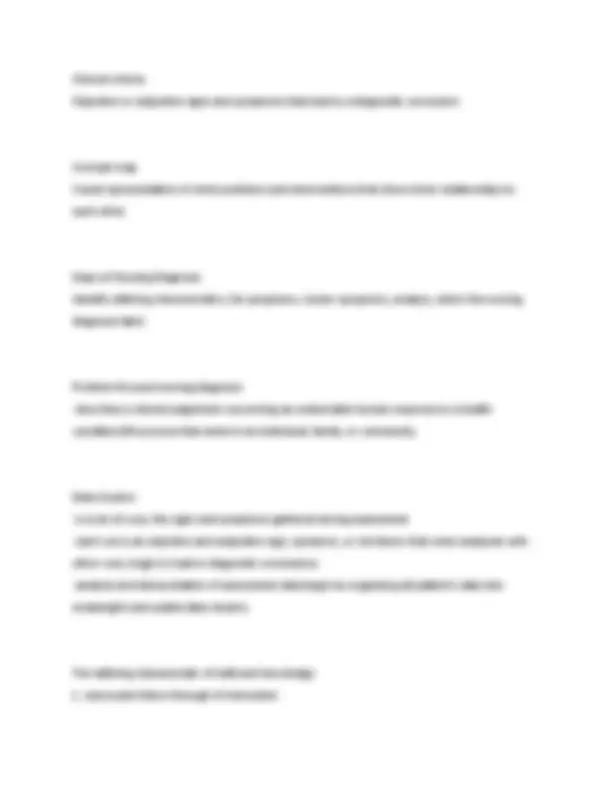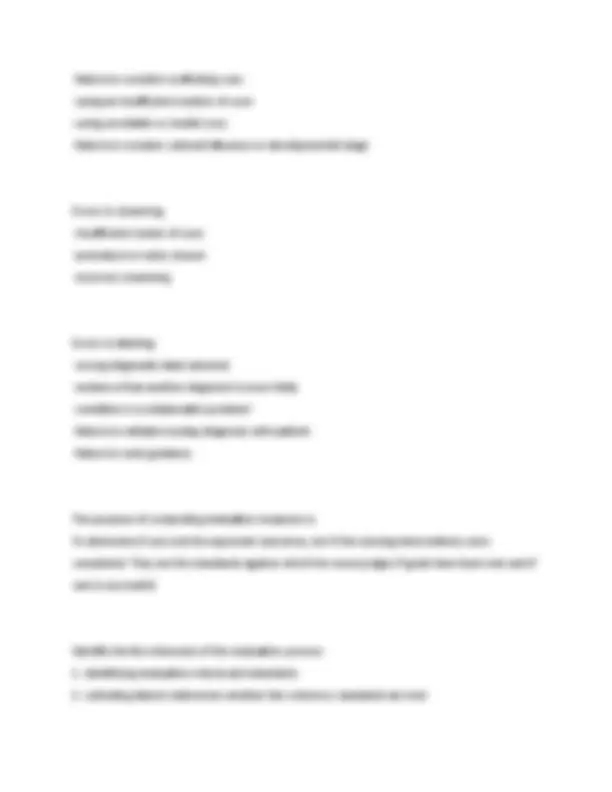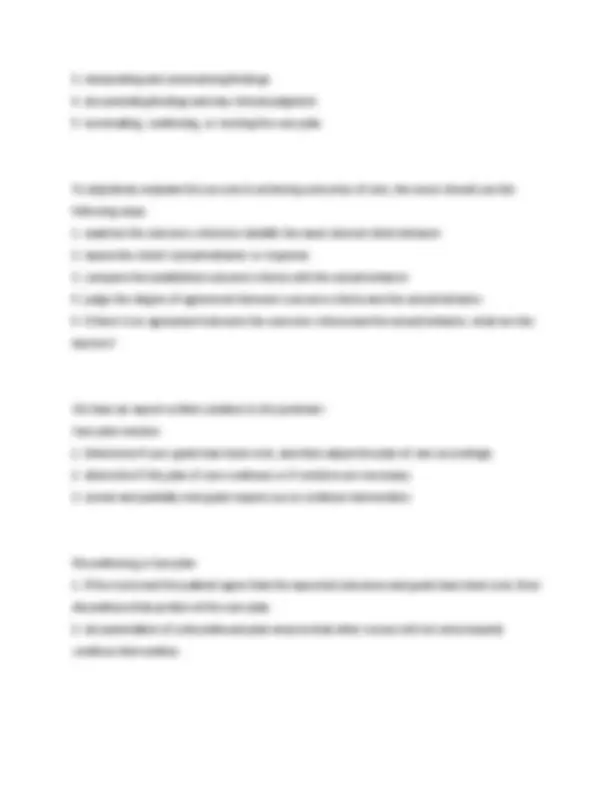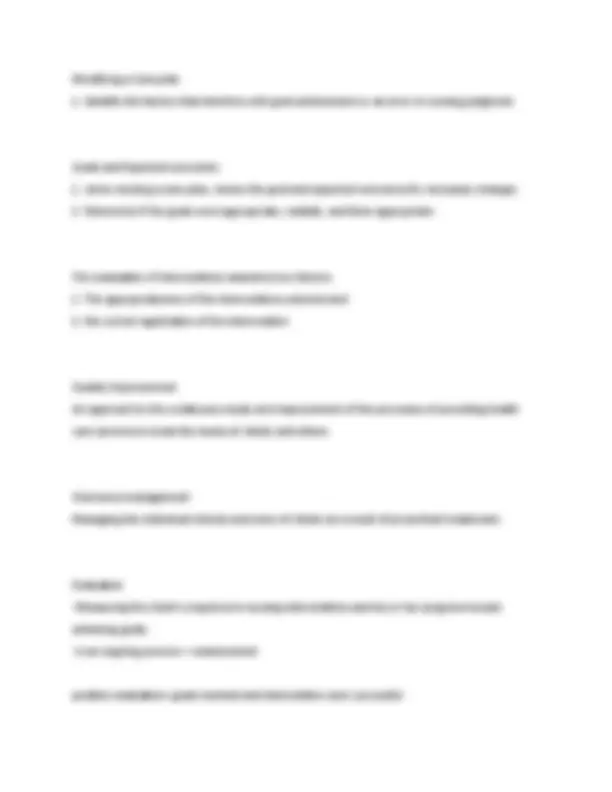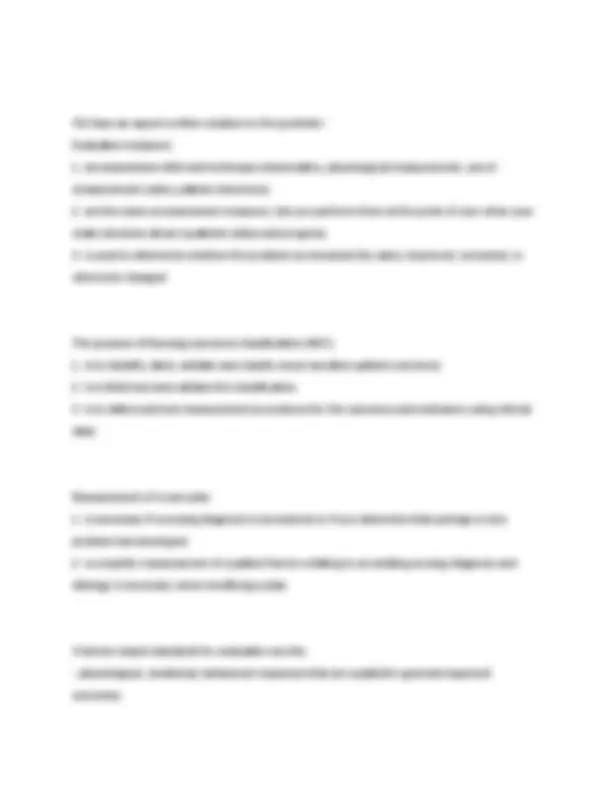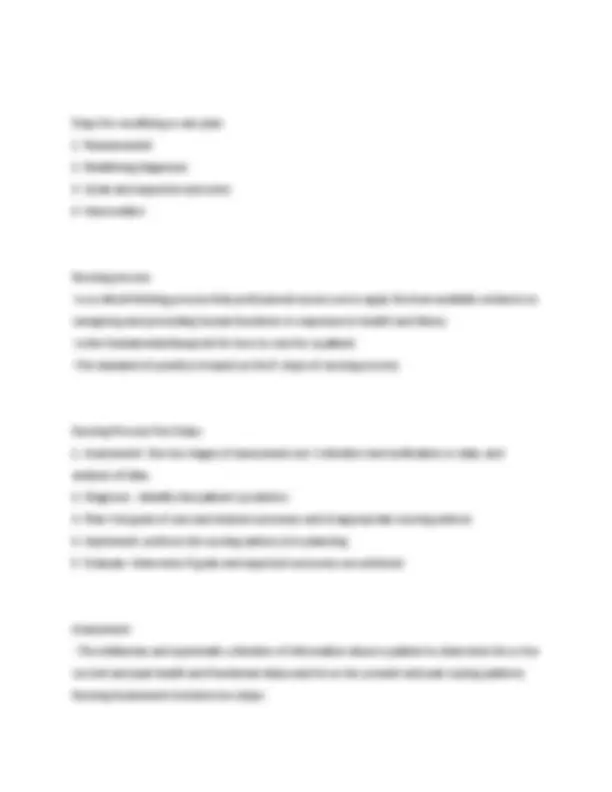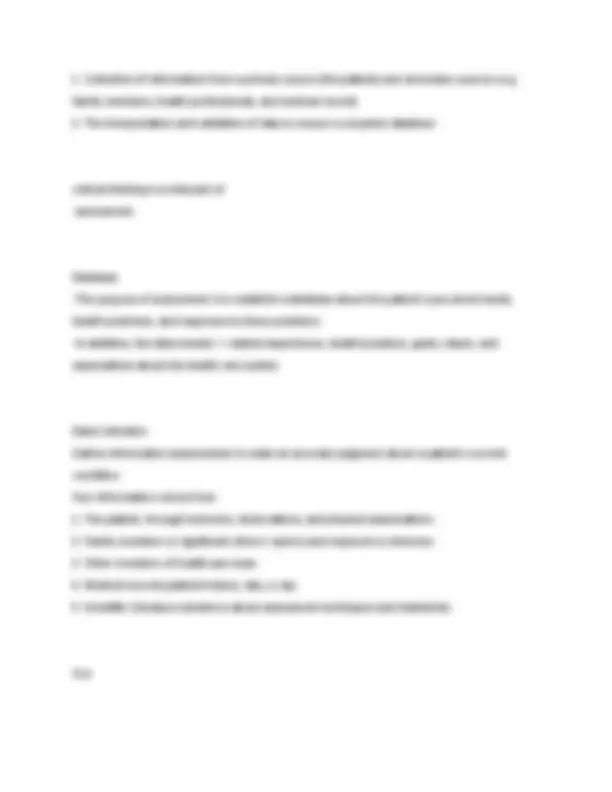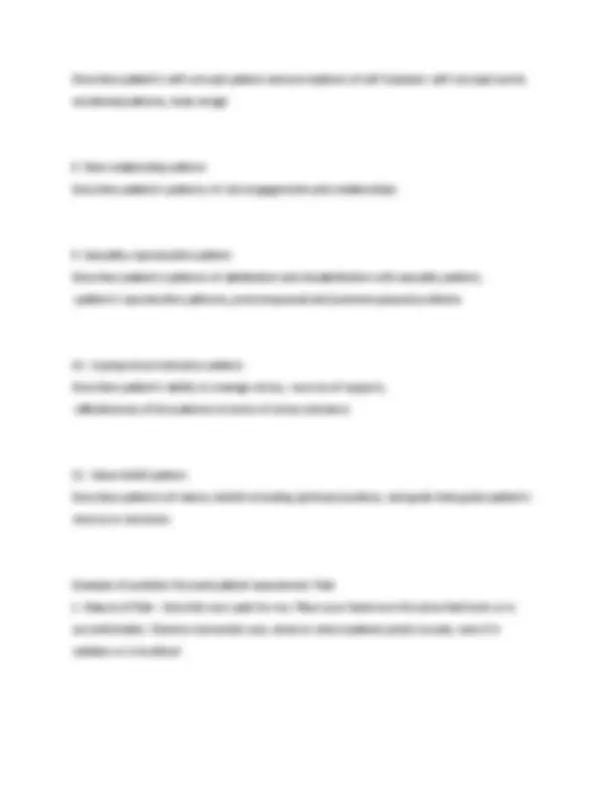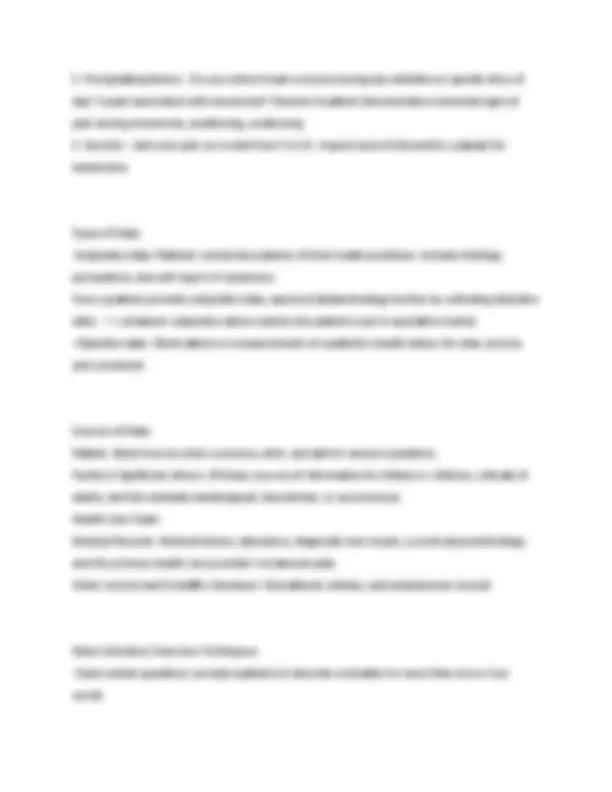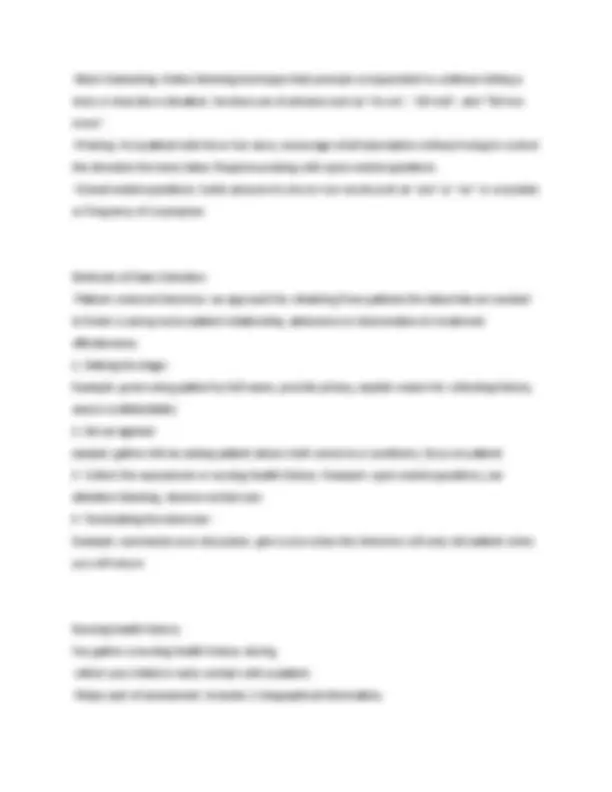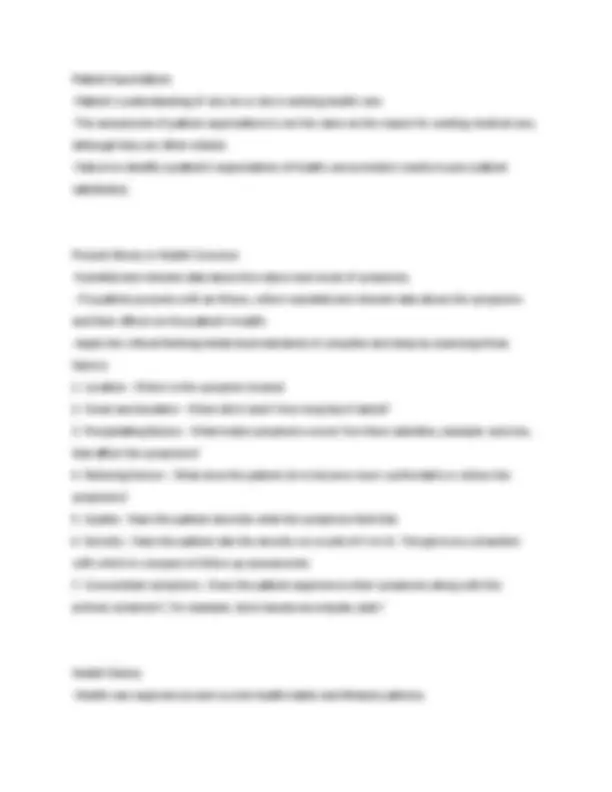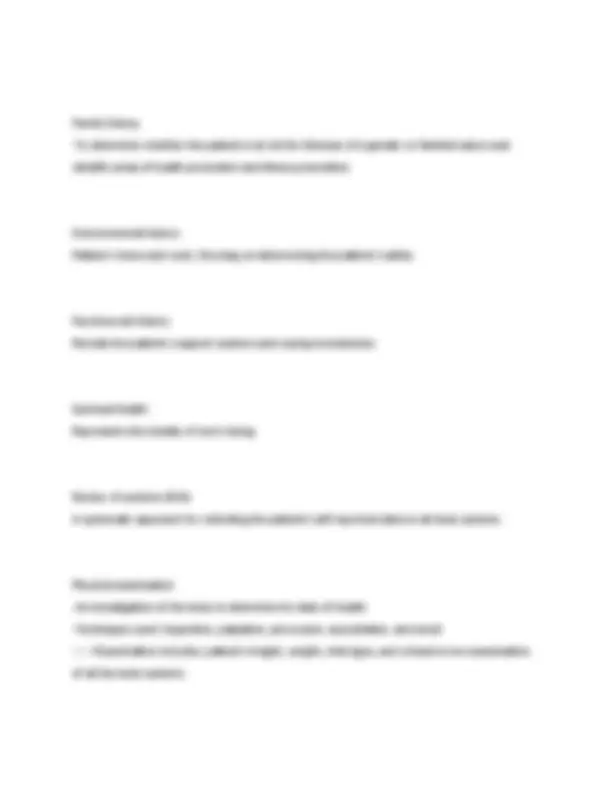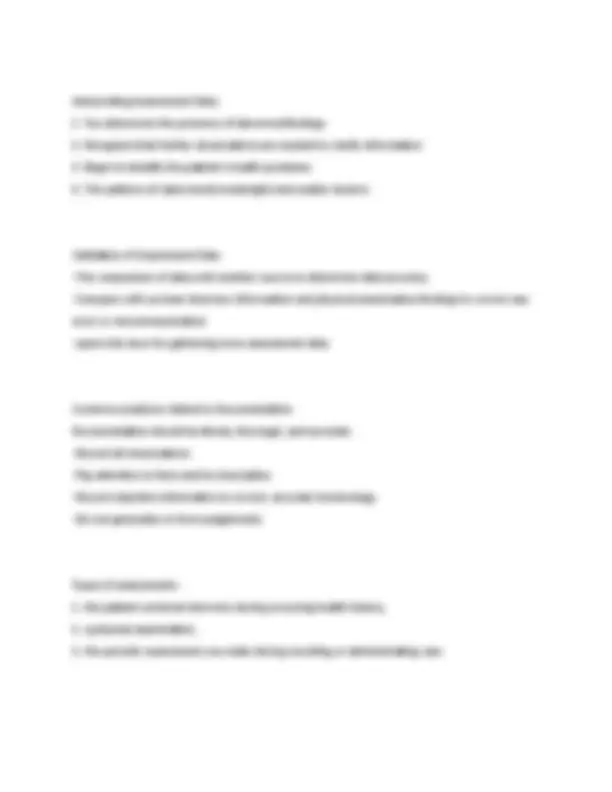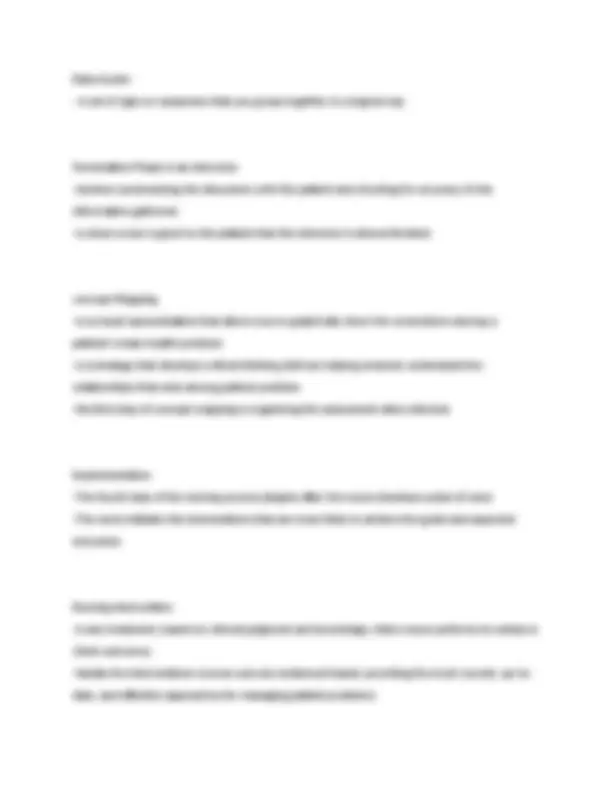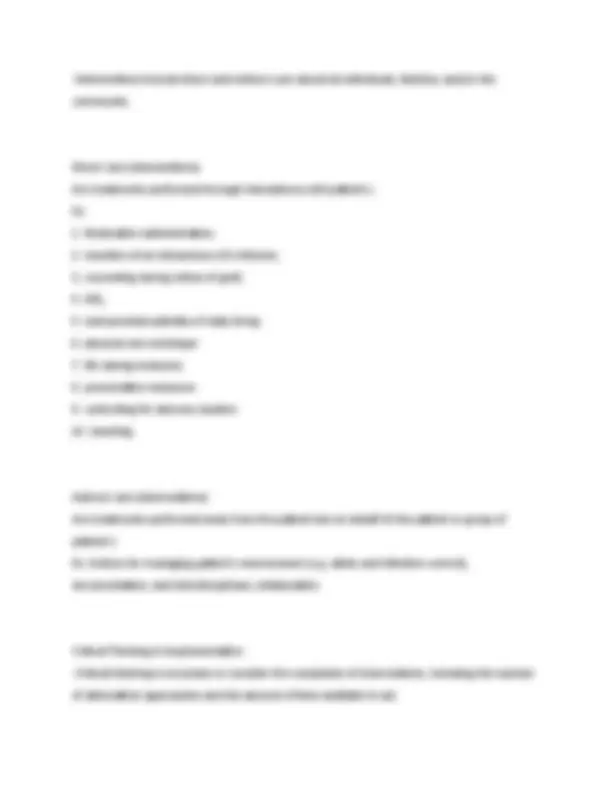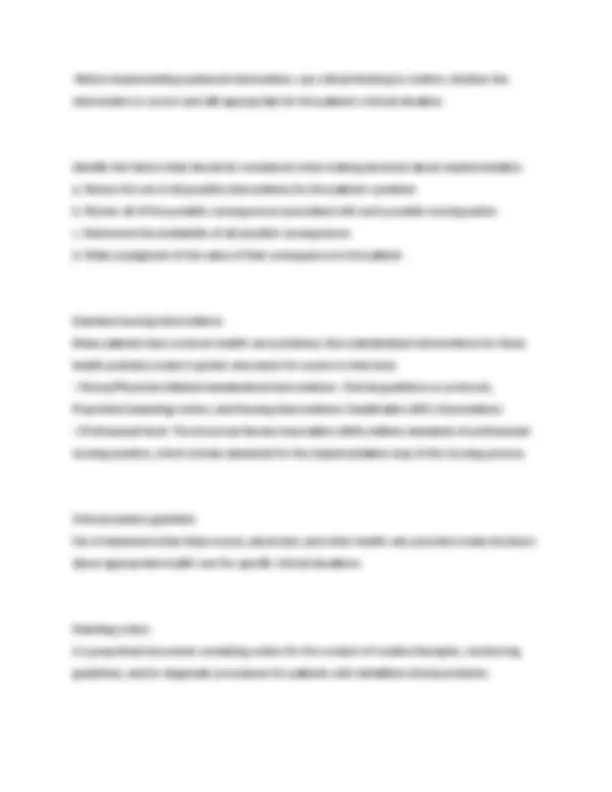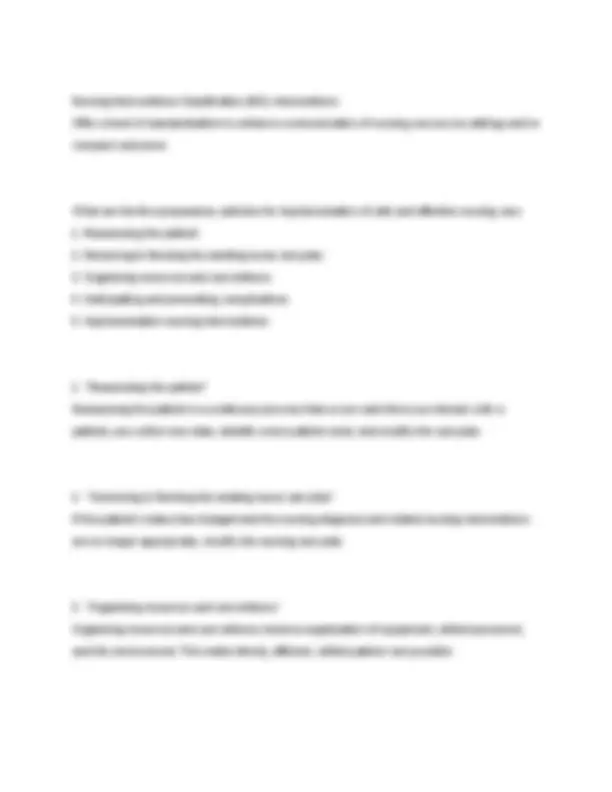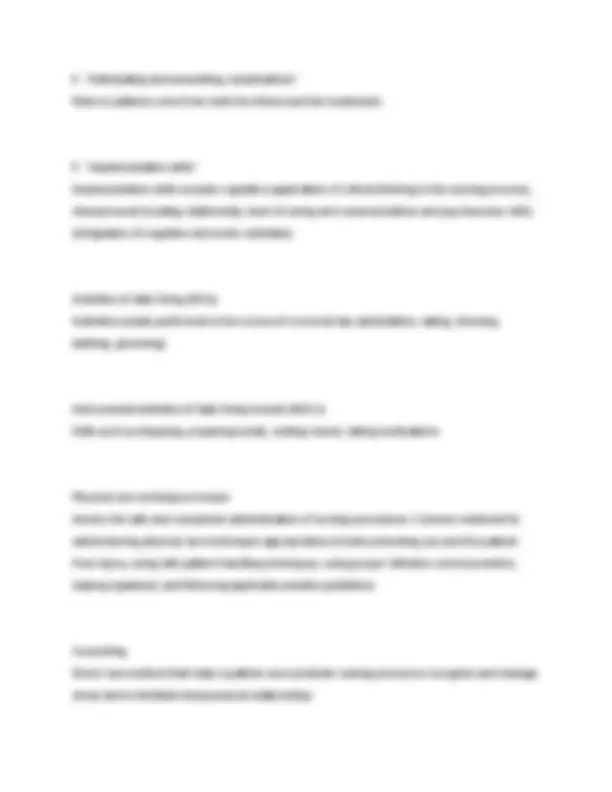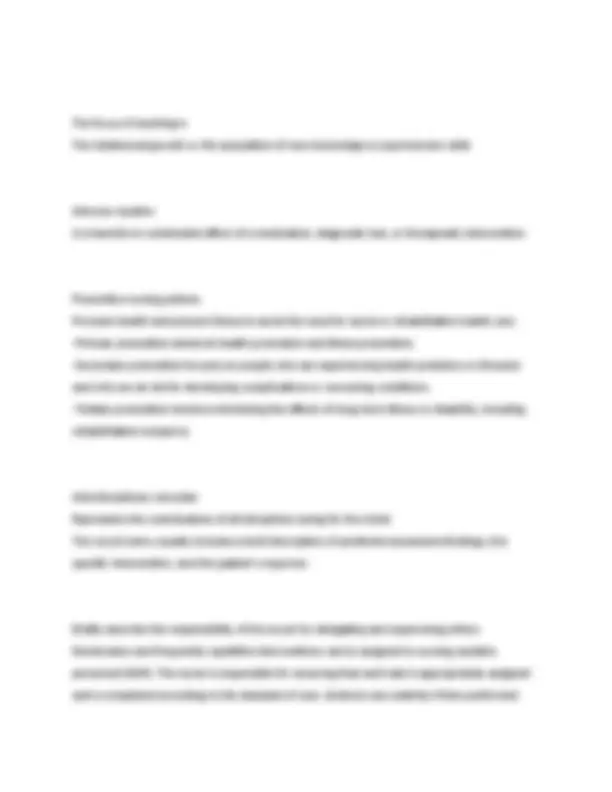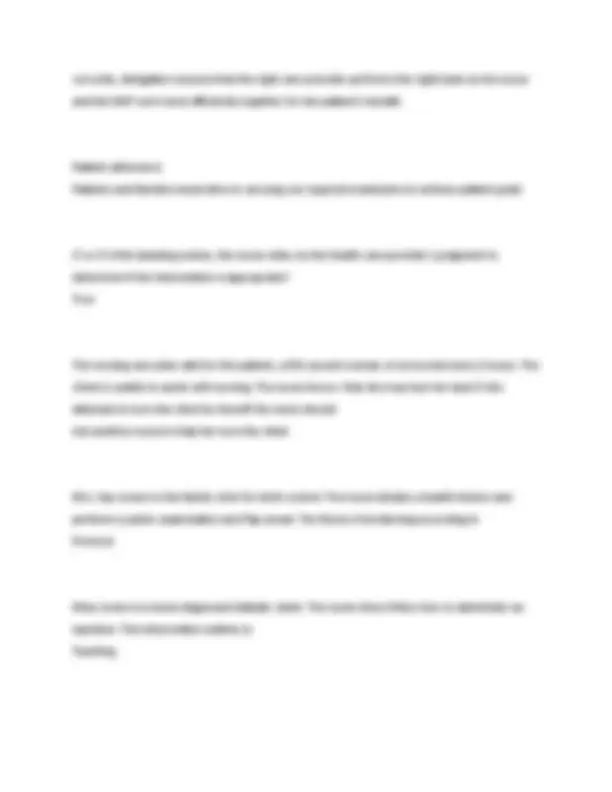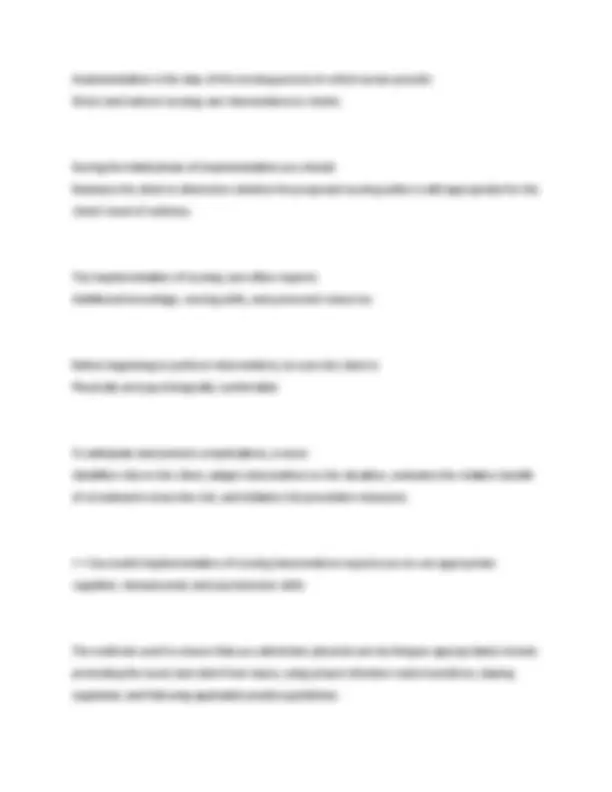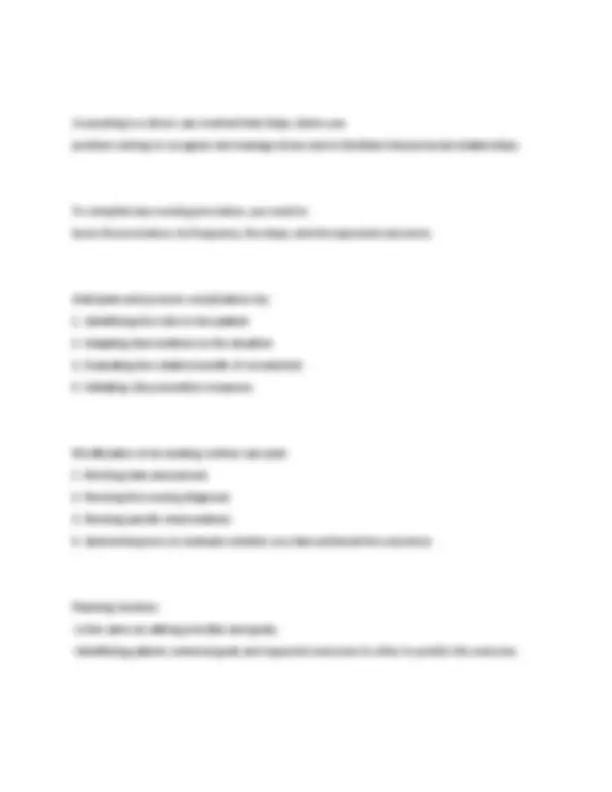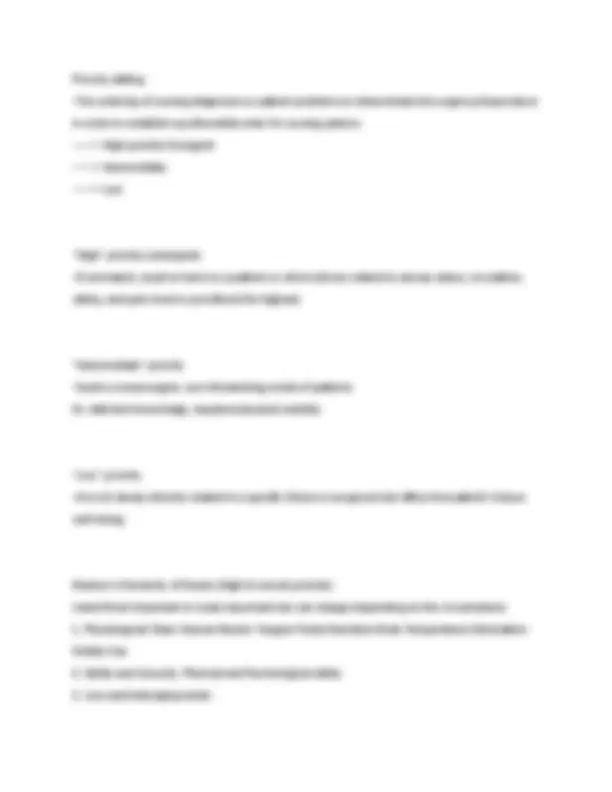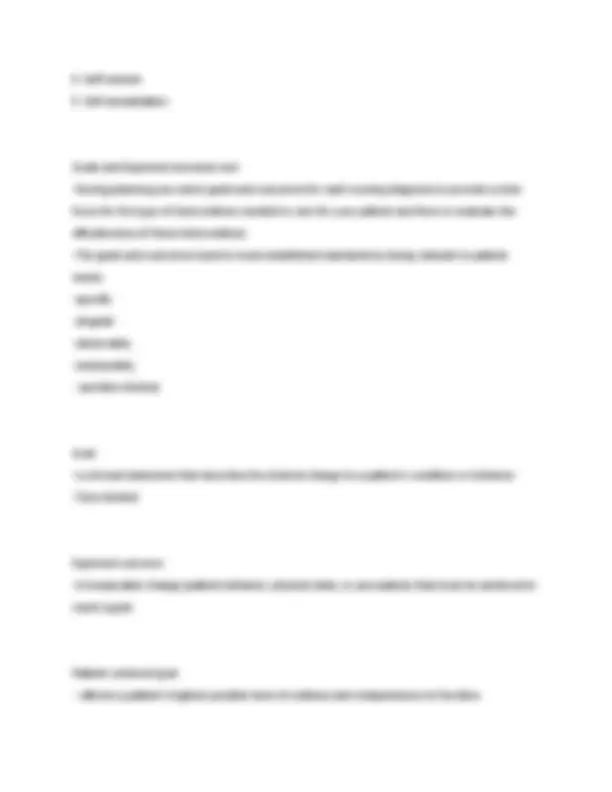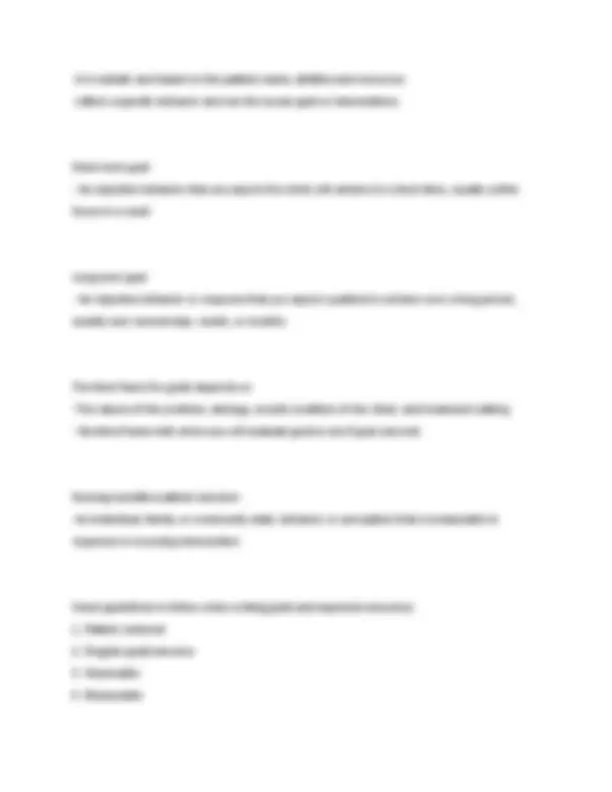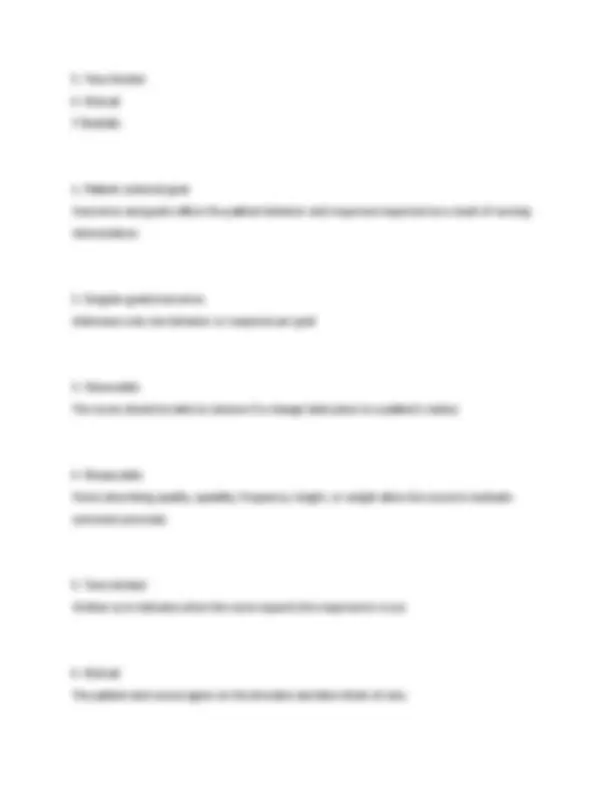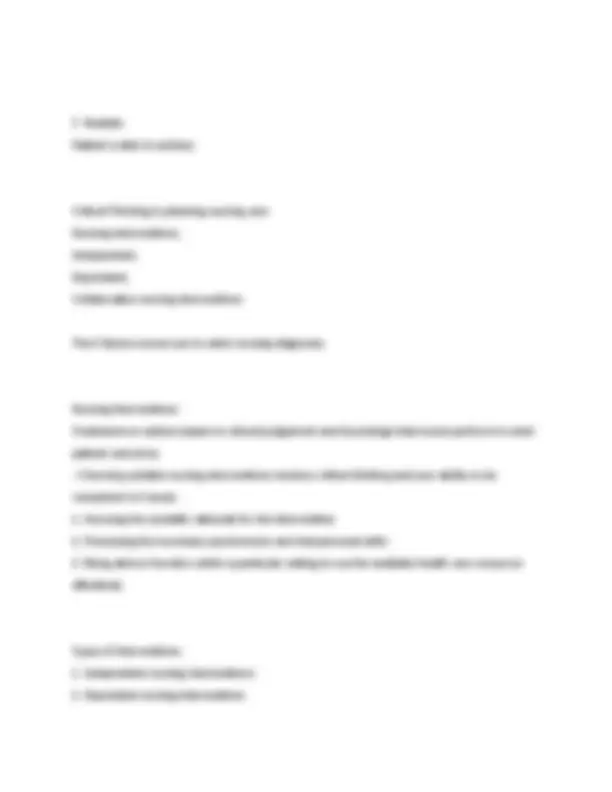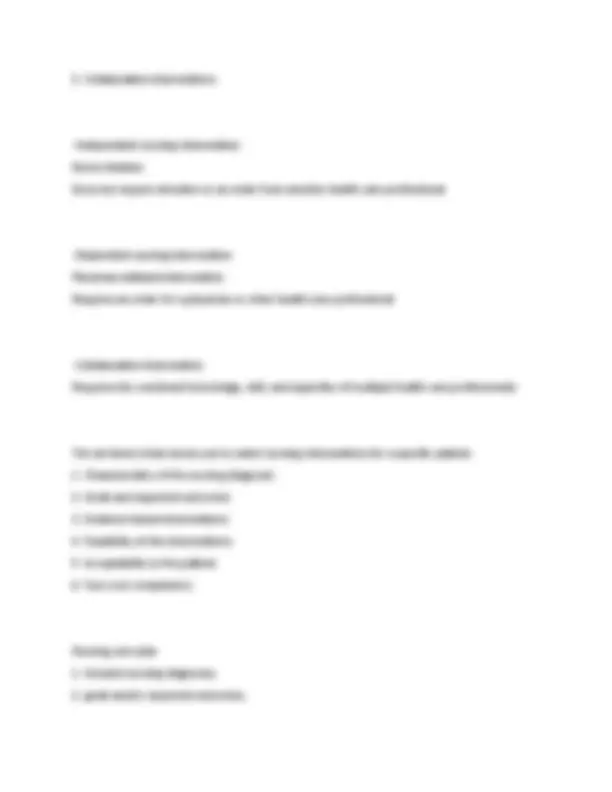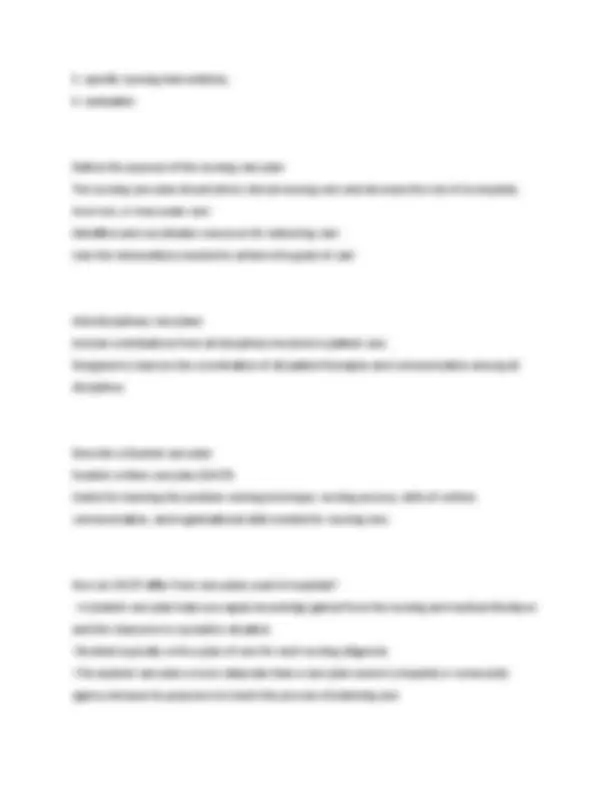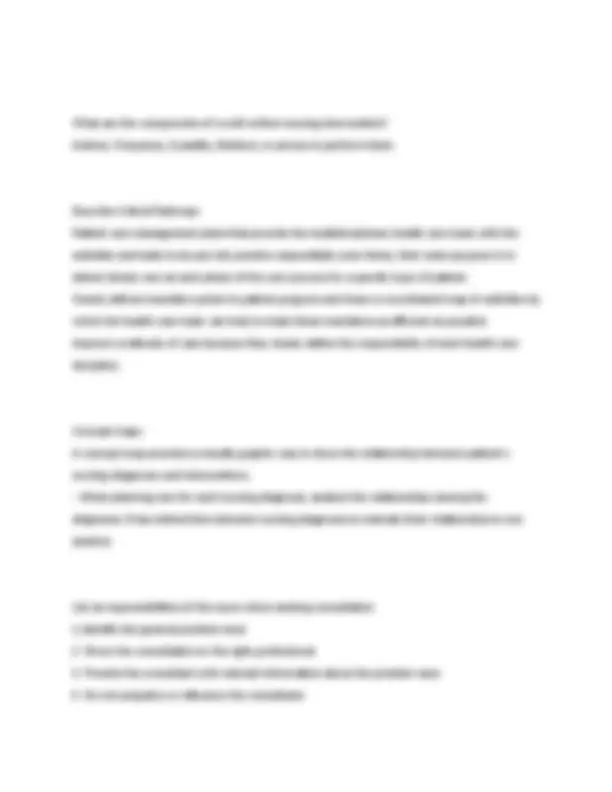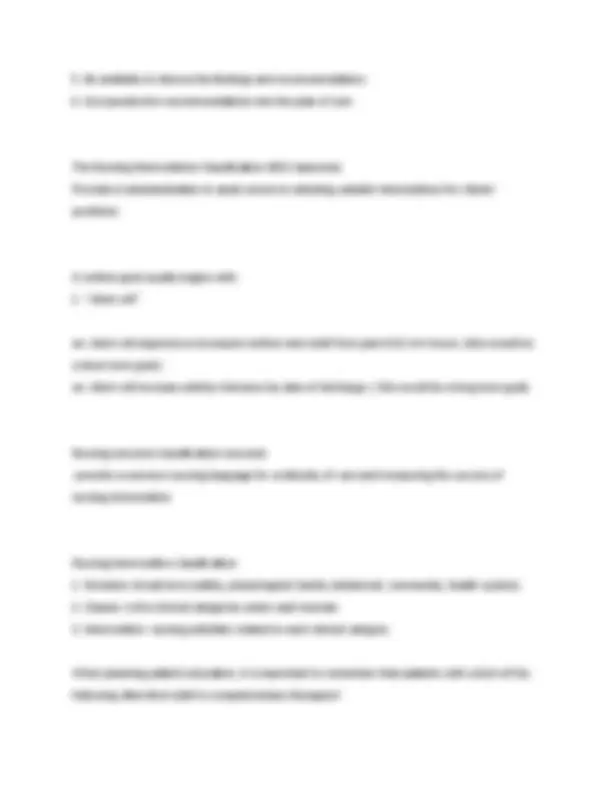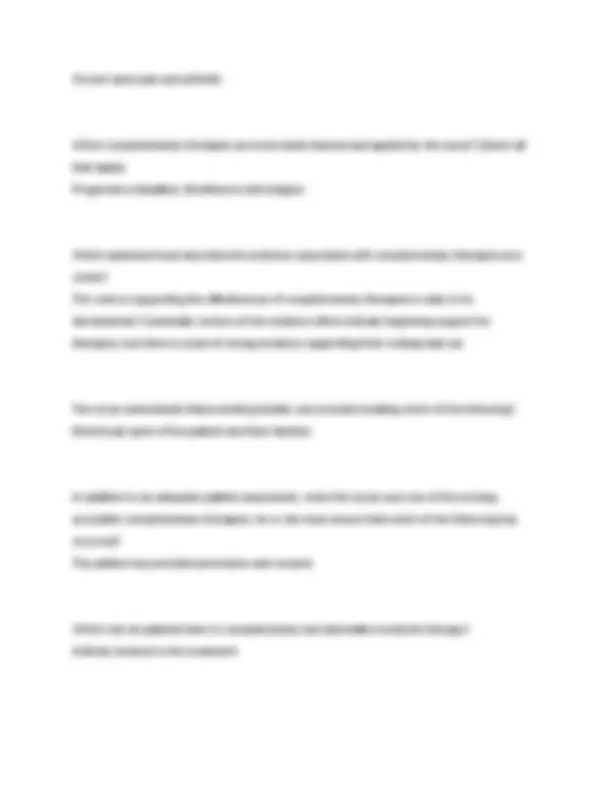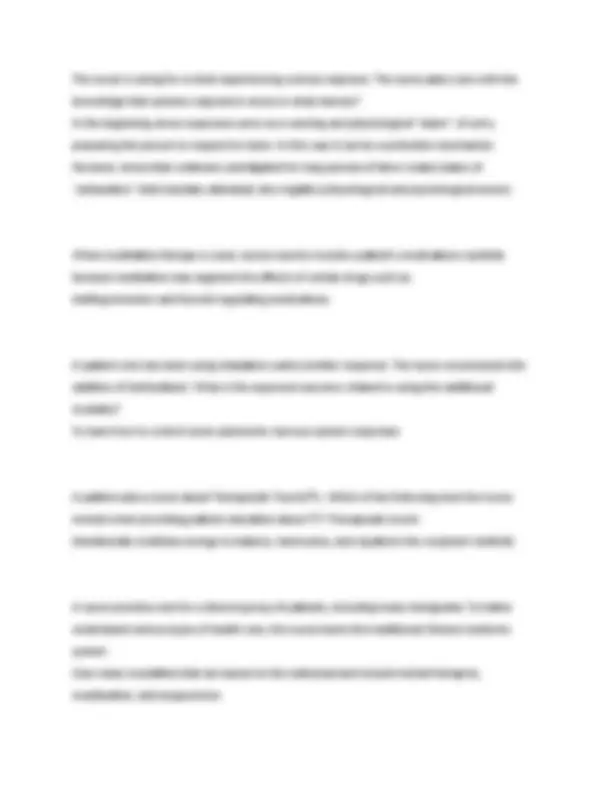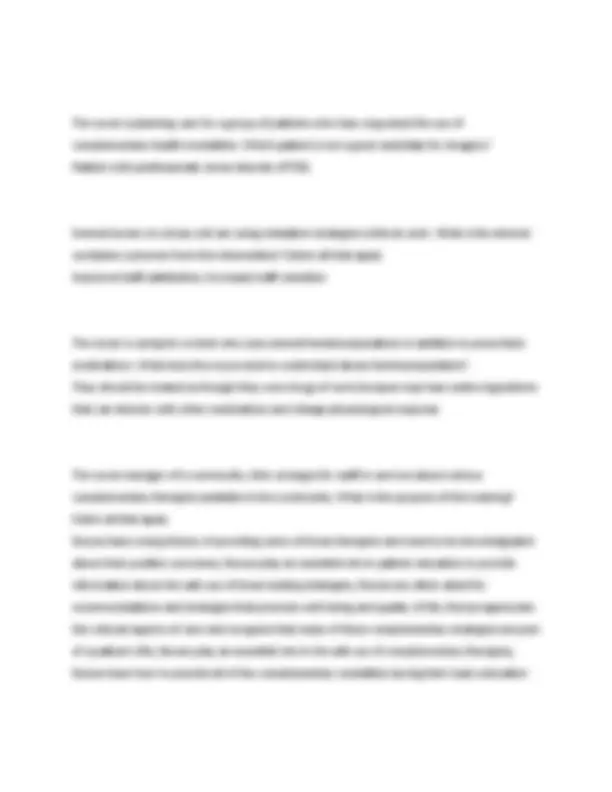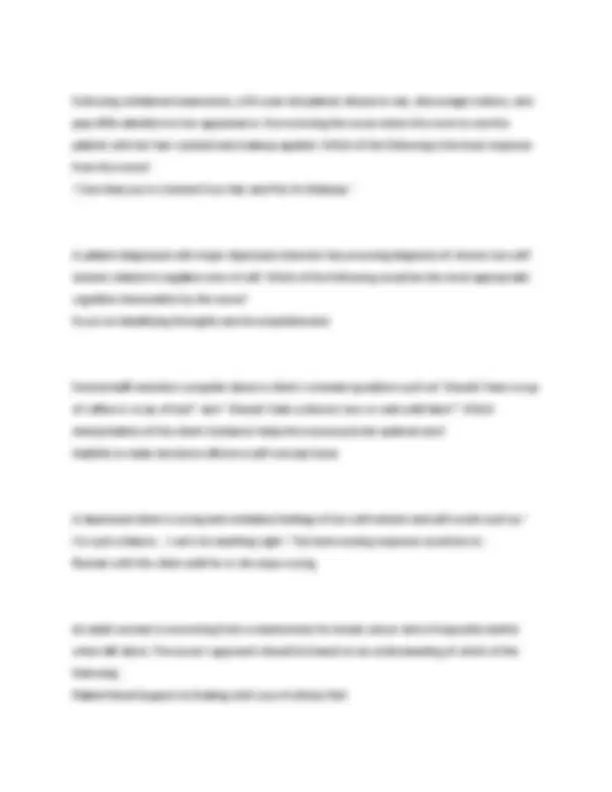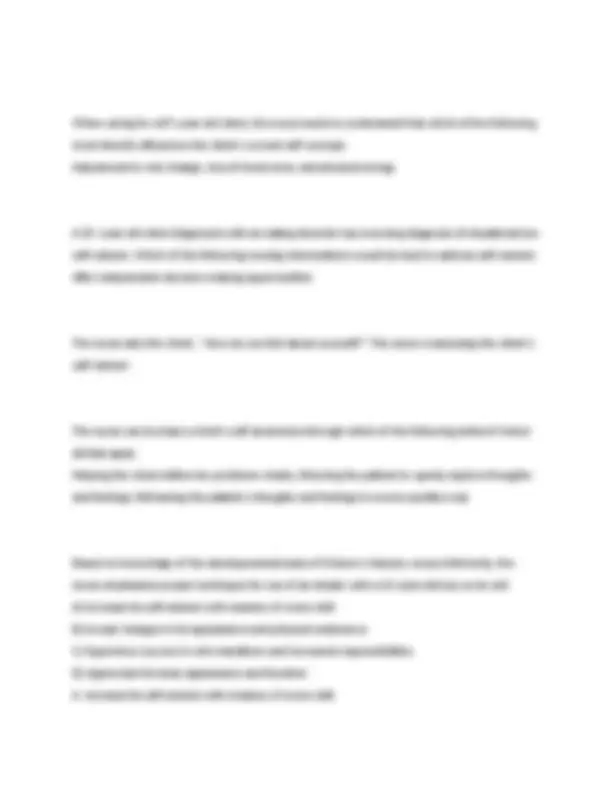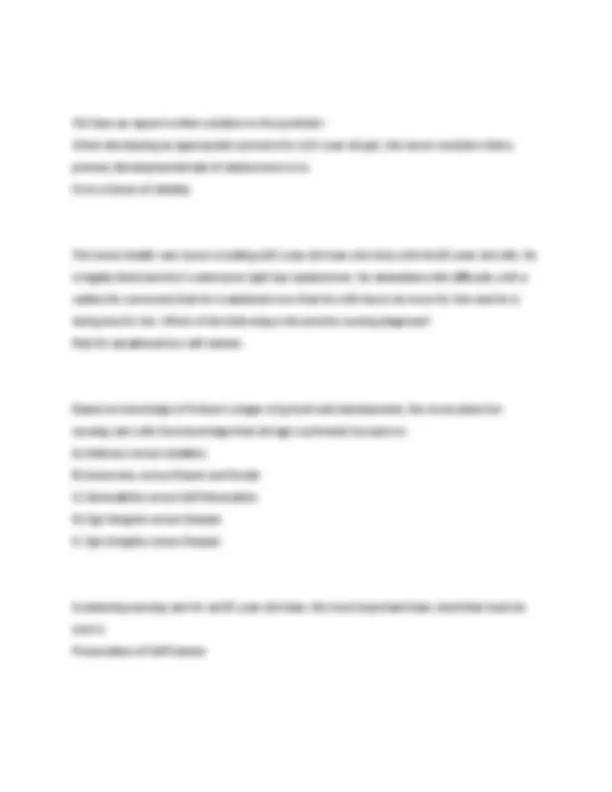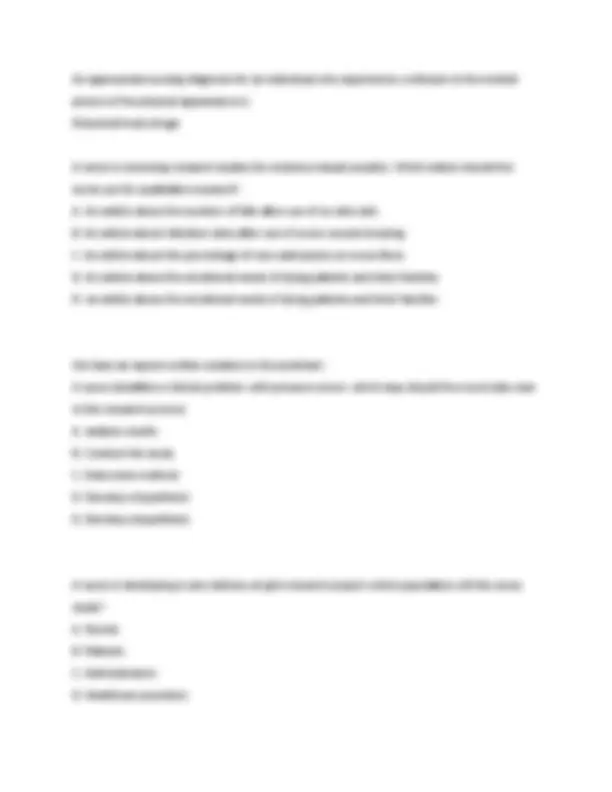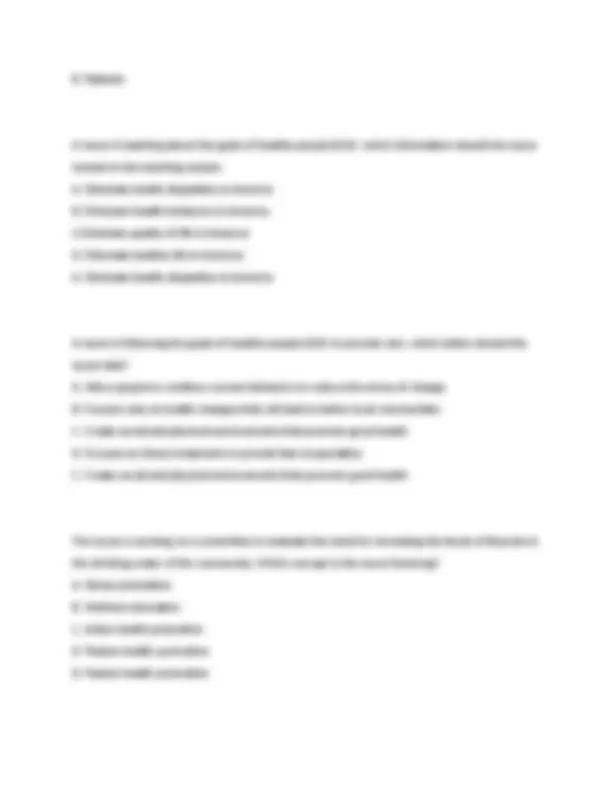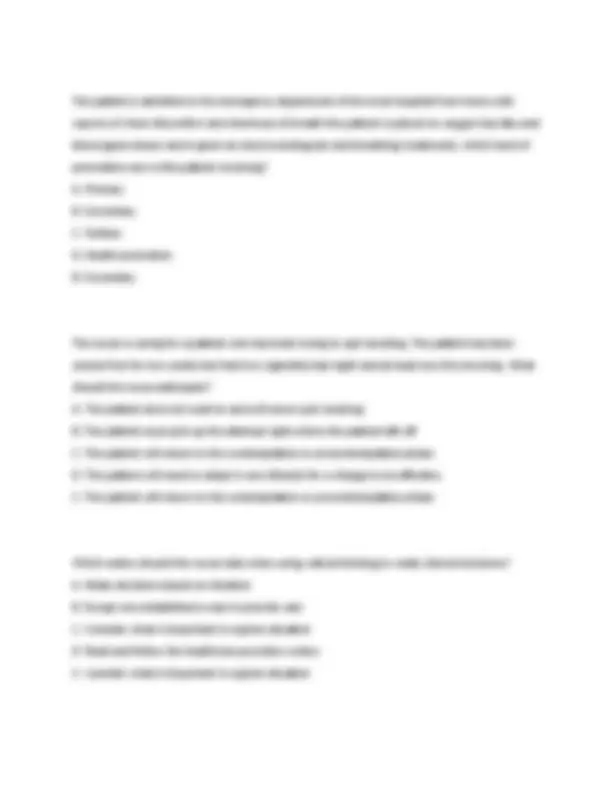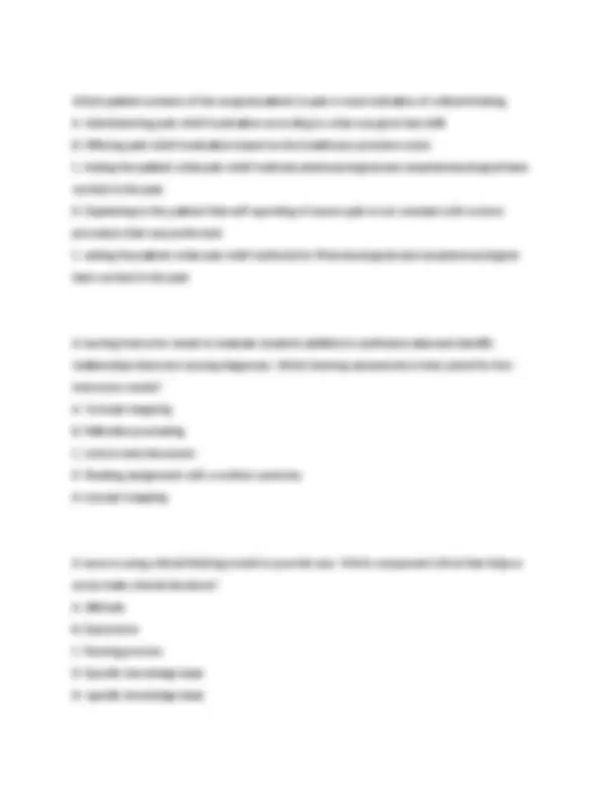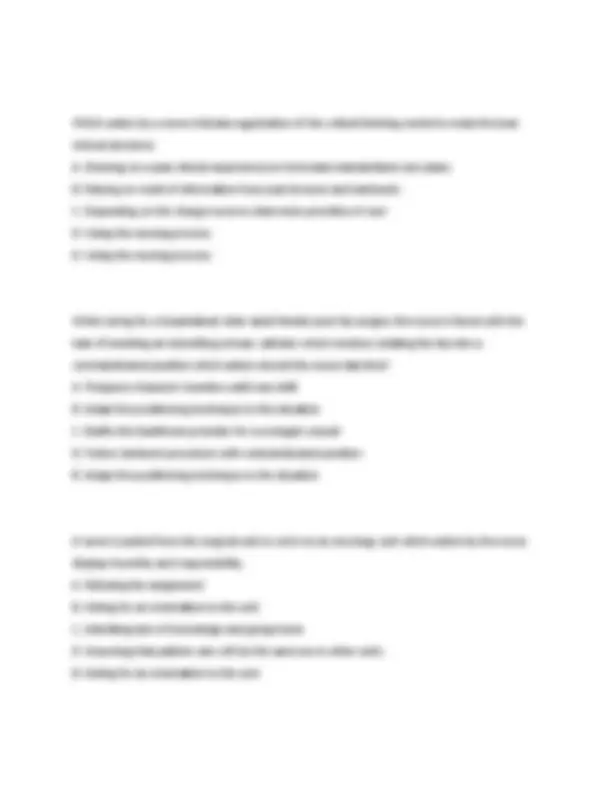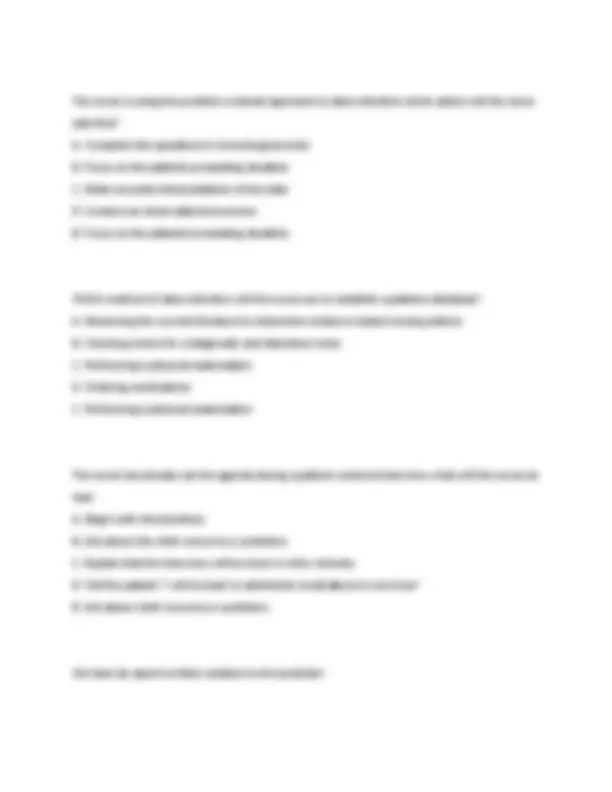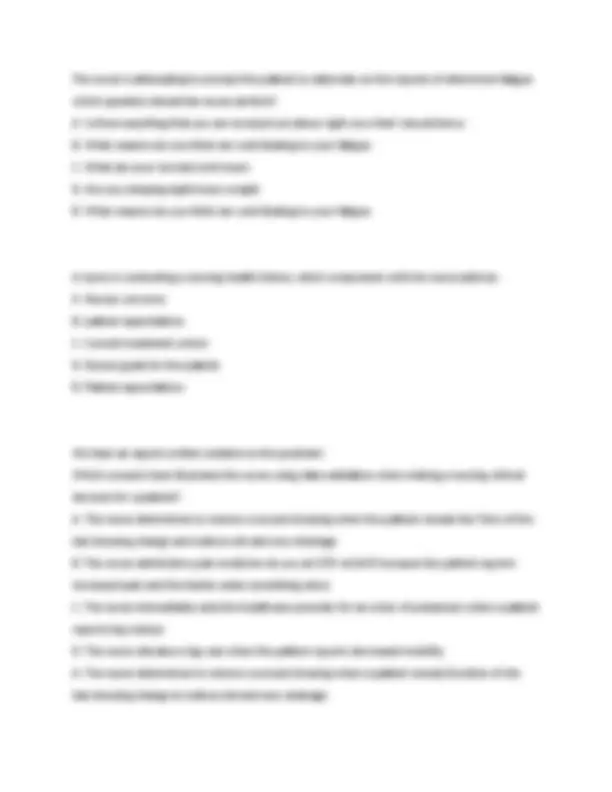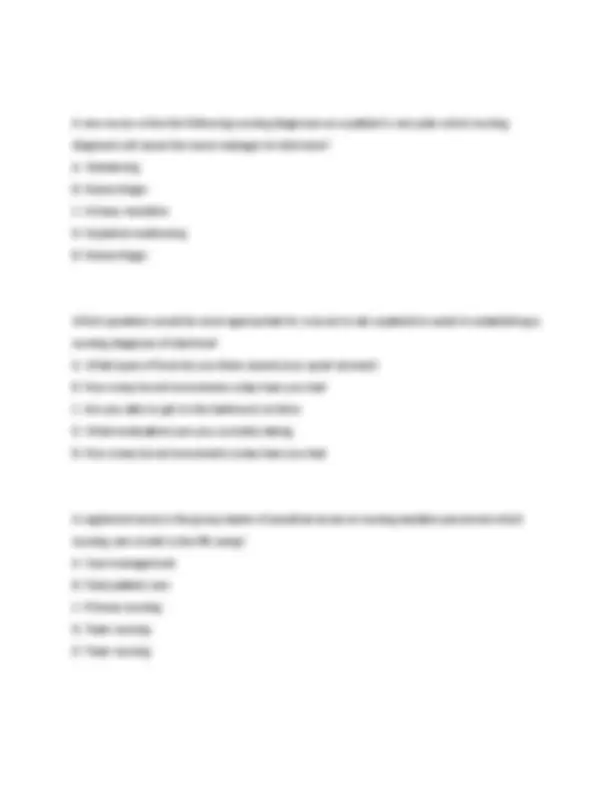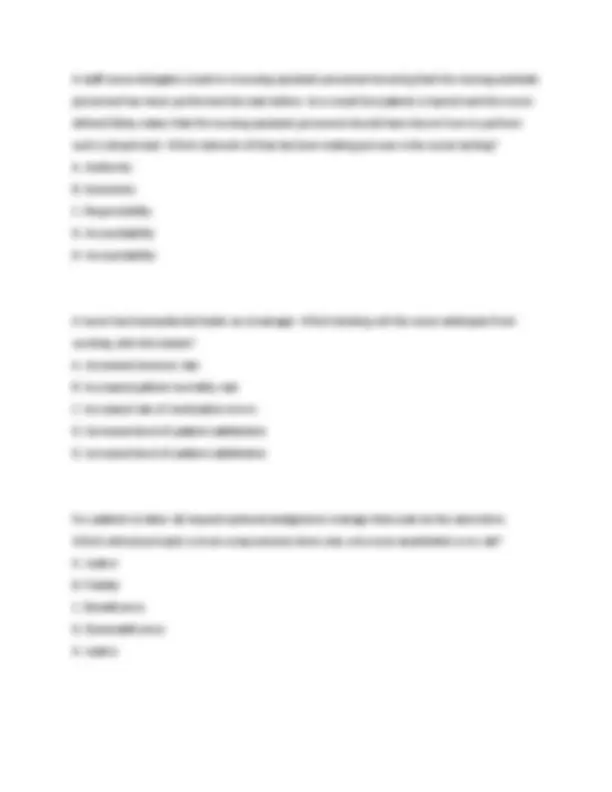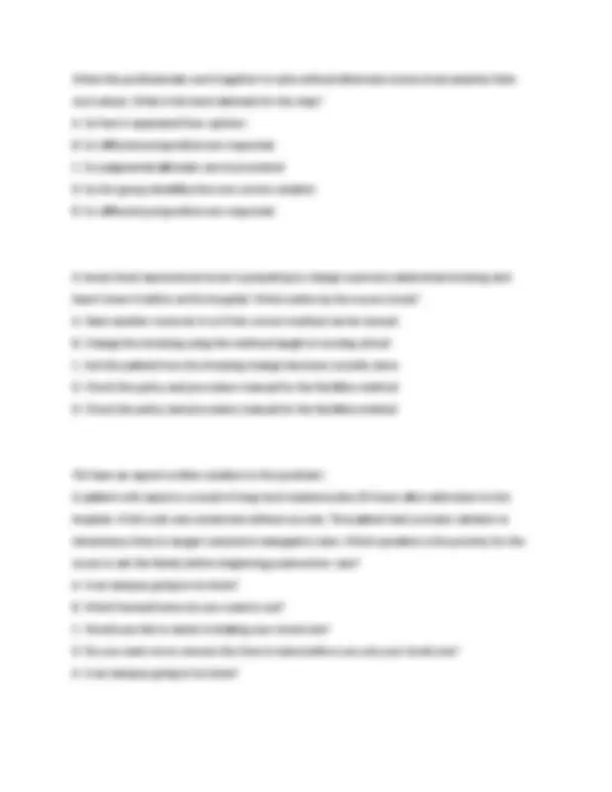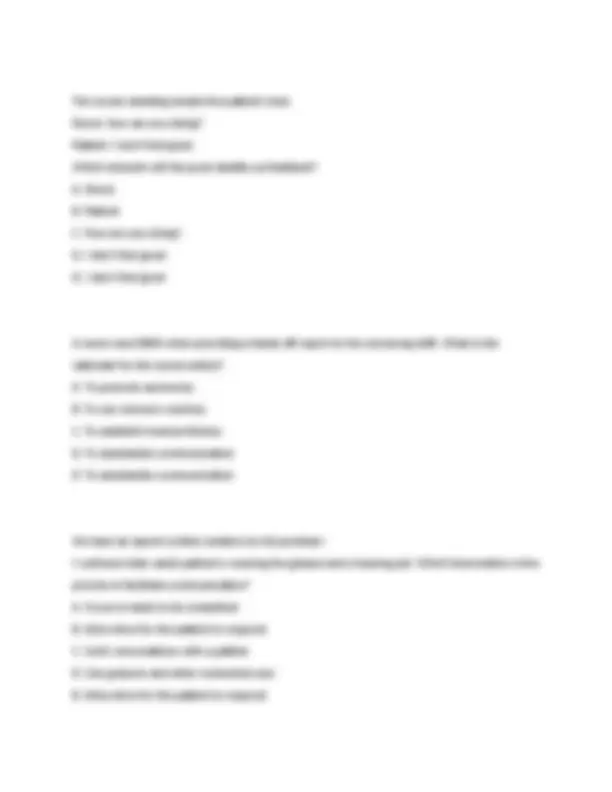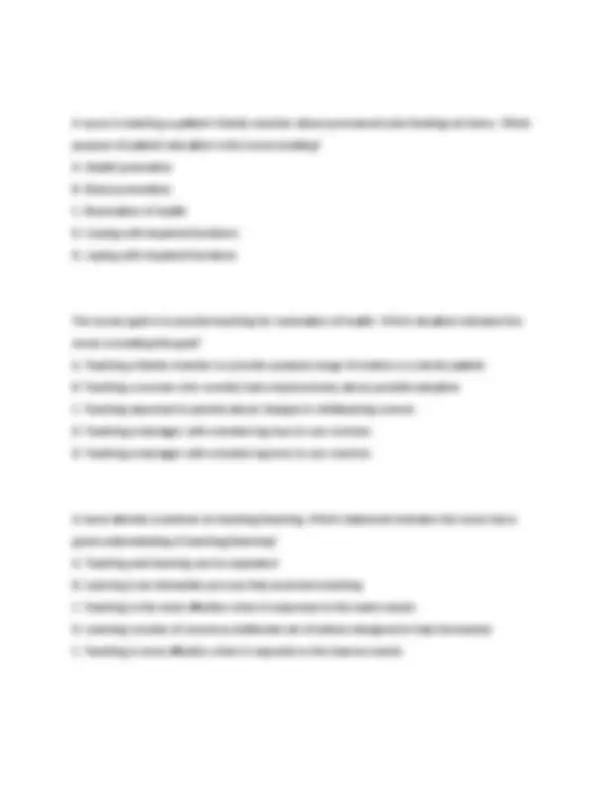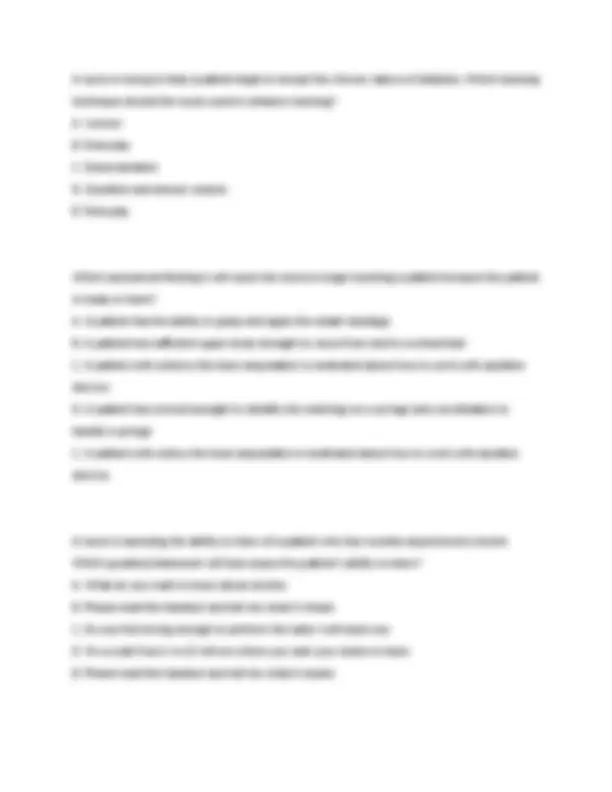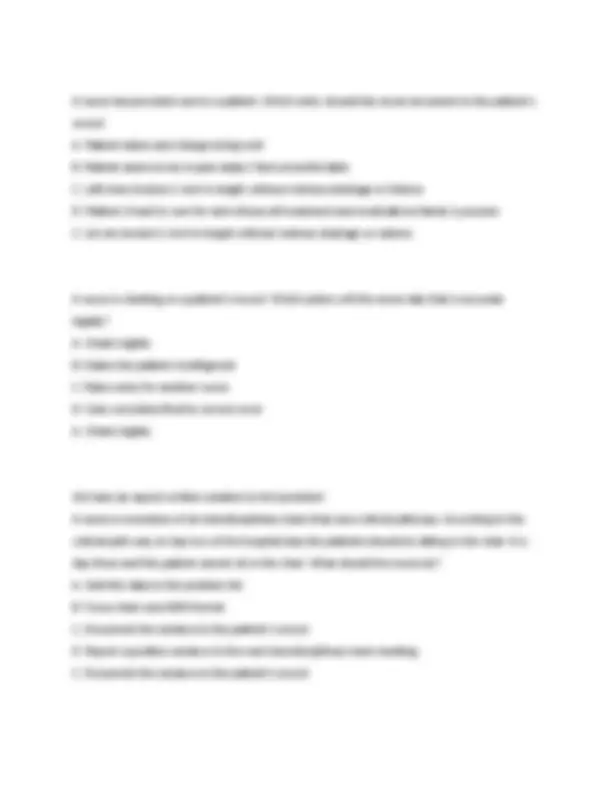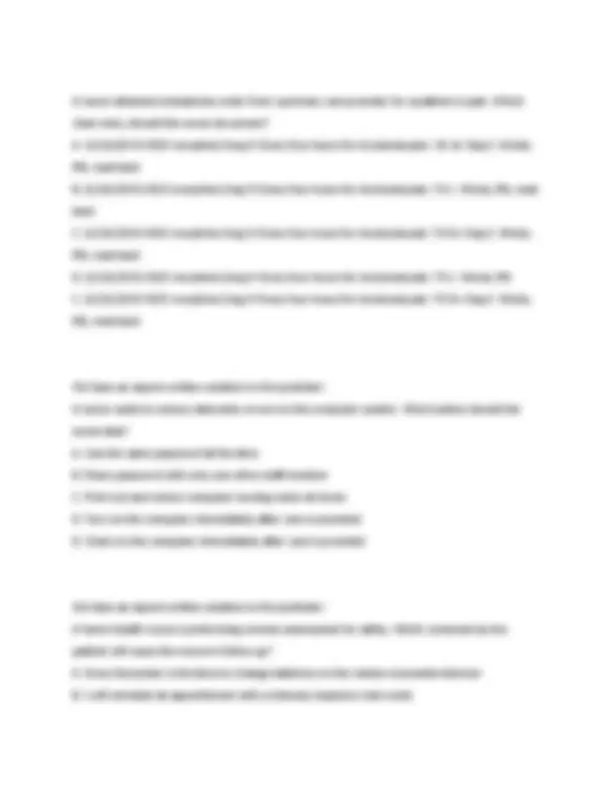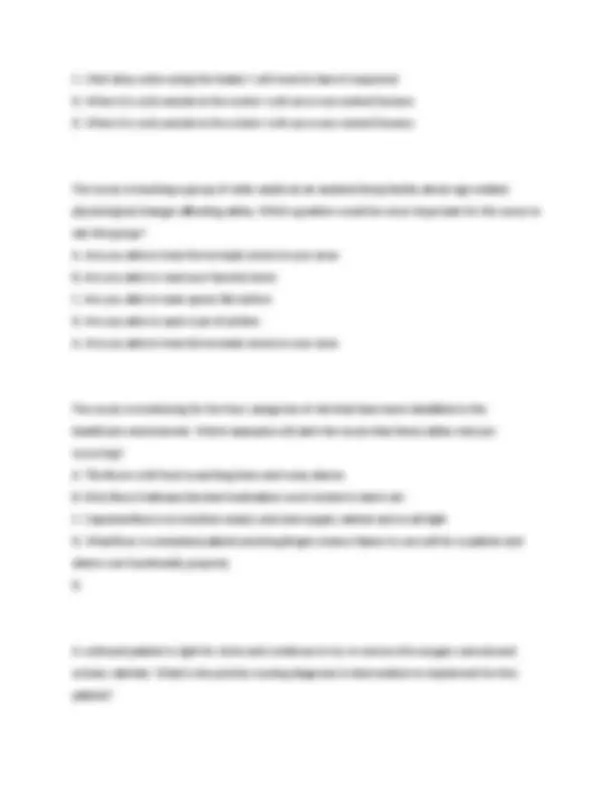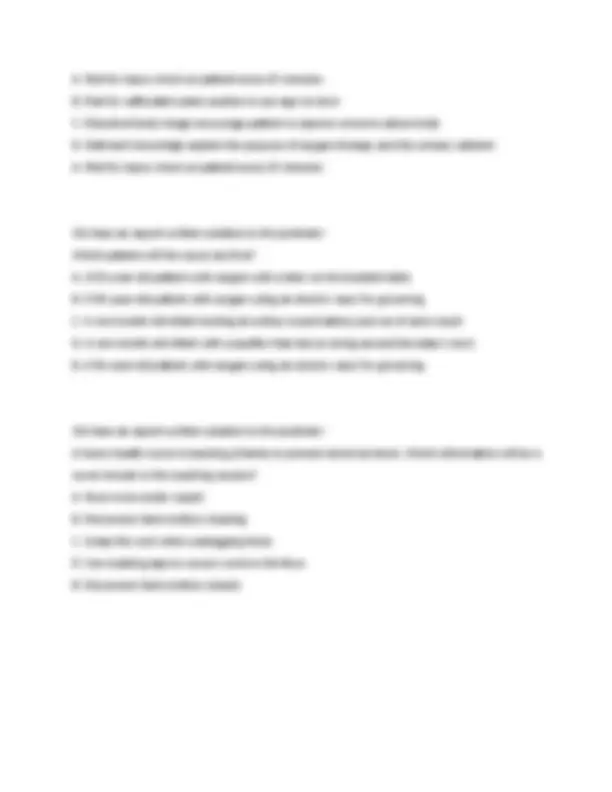Download (NURSING) Fundamentals of Nursing 10th Edition Potter Perry Test Bank Complete Solution and more Exams Nursing in PDF only on Docsity!
(NURSING) Fundamentals of Nursing 10th Edition Potter Perry Test
Bank Complete Solution
Medical diagnosis Identification of a disease condition based on:
- a specific evaluation of a physical sign and symptoms
- a patient’s medical history
- and the results of diagnostic test and procedures.
- stays constant as a condition remains. Collaborative problem
- is an actual or potential physiological complication that nurses monitor to detect the onset of changes in a patient's health status. Client-centered problems Nursing interventions are defined in terms of clients' problems Defining characteristics Assessment findings that support a nursing diagnosis Nursing diagnosis
- is a clinical judgment concerning a human responses to health conditions/life processes that a nurse is licensed and competent to treat.
- is also known as a patients problem.
- is a common language for understanding patients needs.
- allows nurses to communicate plan of care
- distinguishes the nurses role.
- it helps prioritize 7.. is always changing on the basis of a patient's care. -----> explains to others how the patients body responds to the medical diagnosis Risk nursing diagnosis
- Human responses to health conditions that may possibly develop due to risk factors.
- risk diagnosis has risk factors. Health promotion behavior nursing diagnosis
- is when a patient is motivated and desires to increase well-being and actualize human health potential.
- You select this type of diagnosis when the client wishes to or has achieved an optimal level of health Diagnostic label Is the name of the diagnosis as approved by NANDA; it describes the essence of the client's response to health conditions Related factor Is a condition or etiology identified from the client's assessment data, actual or potential responses to the health problem
Identify the step to take to avoid the diagnostic errors in interpretation and analysis of data. Review your data base to decide if it is accurate and complete; be careful to consider any conflicting cues or if there is insufficient cues to confirm a diagnosis. Identify the step to take to avoid the diagnostic errors in data clustering Avoid premature clustering of data; always identify the nursing diagnosis from the data, not the reverse. Identify the step to take to avoid the diagnostic errors in the diagnostic statement:
- Word the diagnostic statement in appropriate, concise, and precise language;
- use correct terminology;
- identify the client problem rather than the goal;
- make professional rather than prejudicial judgments; avoid legally inadvisable statements. Actual problem nursing diagnosis
- describes human response to health conditions or life processes. The first part of the nursing diagnosis statement identifies what? An actual or potential health problem "Related to" Connects the second part of the nursing diagnosis statement to the first part
Clinical criteria Objective or subjective signs and symptoms that lead to a diagnostic conclusion Concept map Visual representation of client problems and interventions that shows their relationships to each other. Steps of Nursing Diagnosis identify defining characteristics, list symptoms, cluster symptoms, analyze, select the nursing diagnosis label Problem-focused nursing diagnosis
- describes a clinical judgement concerning an undesirable human response to a health condition/life process that exists in an individual, family, or community. Data clusters
- is a set of cues, the signs and symptoms gathered during assessment
- each cue is an objective and subjective sign, symptom, or risk factor that when analyzed with other cues, begin to lead to diagnostic conclusions.
- analysis and interpretation of assessment data begin by organizing all patient's data into meaningful and usable data clusters. The defining characteristic of deficient knowledge
- inaccurate follow-through of instruction
- As evidenced by- patient states he is experiencing 8/10 on pain scale it is written as: Acute pain related to trauma of incision as evidenced by patient states he is experiencing 8/10 on pain scale. Types of nursing diagnosis
- Actual problem nursing diagnosis.
- Risk problem nursing diagnosis
- Health promotion behavior nursing diagnosis Sources of diagnostic error
- collecting
- interpreting
- clustering
- labeling
- documentation and informatics
- lack of knowledge or skill
- inaccurate data
- missing data
- disorganization
- failure to validate Errors in interpretation and analysis of data
- inaccurate interpretation of cues
- failure to consider conflicting cues
- using an insufficient number of cues
- using unreliable or invalid cues
- failure to consider cultural influence or developmental stage Errors in clustering
- insufficient cluster of cues
- premature or early closure
- incorrect clustering Errors in labeling
- wrong diagnostic label selected
- evidence that another diagnosis is more likely
- condition is a collaborative problem'
- failure to validate nursing diagnosis with patient
- failure to seek guidance The purpose of conducting evaluative measures is To determine if you met the expected outcomes, not if the nursing interventions were completed. They are the standards against which the nurse judges if goals have been met and if care is successful Identify the five elements of the evaluation process
- identifying evaluative criteria and standards
- collecting data to determine whether the criteria or standards are met
Modifying a Care plan
- Identify the factors that interfere with goal achievement or an error in nursing judgment. Goals and Expected outcomes
- when revising a care plan, review the goal and expected outcomes for necessary changes.
- Determine if the goals were appropriate, realistic, and time-appropriate The evaluation of Interventions examines two factors:
- The appropriateness of the interventions selected and
- the correct application of the intervention Quality Improvement An approach to the continuous study and improvement of the processes of providing health care services to meet the needs of clients and others Outcomes management Managing the individual clinical outcomes of clients as a result of prescribed treatments Evaluation
- Measuring the client's response to nursing interventions and his or her progress toward achieving goals.
- is an ongoing process = reassessment positive evaluation= goals reached and intervention were successful
(T or F) Evaluation is not integrated, ongoing nursing care activity False Expected outcomes Criteria used to determine the effective-ness of a nursing action When a client-centered goal has not been met in the projected time frame, the most appropriate action by the nurse would be to: Repeat the entire sequence of the nursing process to discover needed changes Evaluation Allows nurses to determine whether nursing interventions are successful in improving a client's condition or well-being Evaluation involves what two components An examination of a condition or situation and a judgment as to whether change has occurred. During evaluation you should apply critical thinking to make clinical decisions and redirect nursing care to best meet client needs Positive evaluations occur when you meet...
We have an expert-written solution to this problem! Evaluative measures
- are assessment skills and technique (observation, physiological measurement, use of measurement scales, patient interviews).
- are the same as assessment measures, but you perform them at the point of care when your make decisions about a patients status and progress.
- is used to determine whether the problem as remained the same, improved, worsened, or otherwise changed. The purpose of Nursing outcomes classification (NOC)
- is to identify, label, validate and classify nurse-sensitive patient outcomes.
- is to field test and validate the classification.
- is to define and test measurement procedures for the outcomes and indicators using clinical data. Reassessment of a care plan
- is necessary if a nursing diagnosis is unresolved or if you determine that perhaps a new problem has developed.
- a complete reassessment of a patient factors relating to an existing nursing diagnosis and etiology is necessary when modifying a plan. Criterion-based standards for evaluation are the
- physiological, emotional, behavioral responses that are a patient's goal and expected outcomes.
Steps for modifying a care plan
- Reassessment
- Redefining diagnoses
- Goals and expected outcomes
- Intervention Nursing process
- is a critical thinking process that professional nurses use to apply the best available evidence to caregiving and promoting human functions in responses to health and illness.
- is the fundamental blueprint for how to care for a patient.
- The standard of practice is based on the 5 steps of nursing process. Nursing Process Five Steps
- Assessment - the two stages of assessment are: Collection and verification or data, and analysis of data.
- Diagnose - identify the patient's problems
- Plan- Set goals of care and desired outcomes and id appropriate nursing actions
- Implement- perform the nursing actions id in planning
- Evaluate- determine if goals and expected outcomes are achieved Assessment
- The deliberate and systematic collection of information about a patient to determine his or her current and past health and functional status and his or her present and past coping patterns. Nursing Assessment includes two steps:
Information that a nurse obtain through the use of the senses (hearing, visual observations, touch, and smell). Inference Your judgment or interpretation of the cues Example: A patient crying is a cue that possibly implies fear or sadness Observational overview using cues and forming inferences. Male patient in bed, looks uncomfortable. Patient presents with discomfort in surgical area. Cues
- Lies still with arms along sides; tense
- States has not turned for some time
- Reports pain a 7 on a scale of 0 to 10 Inferences
- Pain is severe
- Pain limits patient's ability to move and reposition self 11 Functional health patterns An example of a structured database format, one approach to perform a comprehensive assessment. Gordon's functional health patterns model offers a holistic framework for assessment of any health problem. The health patterns are listed below.
- Health perception-health management pattern Describes patient's self-report of health and well-being; how patient manages health. - Example: frequency of health care provider visits,
- adherence to therapies at home;
- knowledge of preventative health practices
- Nutritional-metabolic pattern Describes patient's daily/weekly pattern of food and fluid intake.
- Example: food preferences or restrictions, special diet, appetite;
- actual weight,
- weight loss or gain
- Elimination pattern Describes pattern of excretory function. Example: bowel, bladder, and skin
- Activity-exercise pattern Describes patterns of exercise, activity, leisure, and recreation;
- ability to perform activities of daily living
- Sleep-rest pattern Describes patterns of sleep, rest, and relaxation.
- Cognitive-perceptual pattern Describes sensory-perceptual patterns; language adequacy, memory, decision-making ability
- Self-perception-self-concept pattern
- Precipitating factors - Do you notice if pain worsens during any activities or specific time of day? Is pain associated with movement? Observe if patient demonstrates nonverbal signs of pain during movement, positioning, swallowing
- Severity - rate your pain on a scale from 0 to 10. Inspect area of discomfort, palpate for tenderness. Types of Data:
- Subjective data- Patients' verbal descriptions of their health problems. Includes feelings, perceptions, and self-report of symptoms. Once a patient provides subjective data, explore/validate findings further by collecting objective data. ---> (whatever subjective data is said by the patient is put in quotation marks)
- Objective data- Observations or measurements of a patient's health status. Be clear, precise and consistent. Sources of Data: Patient- (Best Source) when conscious, alert, and able to answer questions. Family & Significant others- (Primary sources of information for infants or children; critically ill adults; and the mentally handicapped, disoriented, or unconscious) Health Care Team- Medical Records- Medical history, laboratory, diagnostic test results, current physical findings, and the primary health care provider's treatment plan. Other records and Scientific Literature- Educational, military, and employment records Data Collection/ Interview Techniques
- Open-ended questions- prompts patients to describe a situation in more than one or two words.
- Back Channeling- Active listening technique that prompts a respondent to continue telling a story or describe a situation. Involves use of phrases such as "Go on", "Uh huh", and "Tell me more".
- Probing- As a patient tells his or her story, encourage a full description without trying to control the direction the story takes. Requires probing with open-ended questions.
- Closed-ended questions- Limits answers to one or two words such as "yes" or "no" or a number or frequency of a symptom. Methods of Data Collection
- Patient-centered Interview: an approach for obtaining from patients the data that are needed to foster a caring nurse-patient relationship, adherence to interventions & treatment effectiveness.
- Setting the stage- Example: greet using patient by full name, provide privacy, explain reason for collecting history, assure confidentiality
- Set an agenda- xample: gather info by asking patient about chief concerns or problems, focus on patient
- Collect the assessment or nursing health history- Example: open-ended questions, use attentive listening, observe verbal cues
- Terminating the interview- Example: summarize your discussion, give a clue when the interview will end, tell patient when you will return Nursing health history You gather a nursing health history during
- either your initial or early contact with a patient.
- Major part of assessment. Includes: 1.biographical information,

